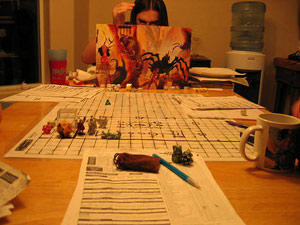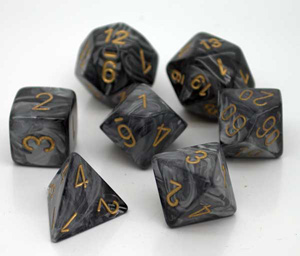
 Role Playing games or RPG's are a type of game that is playing with usually up to four or five friends or other people of similar interest, though it is perfectly possible to have more. Virtually all RPGs can be described as "interactive" or "colabrative" storytelling. By this I mean that people involved in the game collectively tell a story and decide it's outcome. For this to be accomplished first you have to have the setting or "world" that the story will take place it. This can be anything from a ancent fantasy to modern day spy to galactic space battles. Basically pick a literary genre and you can have that as a setting. In every game you have the Game Master (GM) and the Players. The GM is responsible for establishing the story. He provides the players with sinarios, plays the antagonist(s), allies, and other non playable characters (NPCs), gives the players information as appropriate and has final say on questions about how the rules of the game work. The Players control the protagonists of the story. Each player as a Player Character (PC) that they have created to be part of this world. They decide how to have their specific character respond to a given sinario. The collective group of players is called "the party". Each character in the party is generally designed to fulfill a particular role though some games have more defined roles than others. Each role has it's strengths and weaknesses. Having a party that has characters that fulfill different roles from one another lets one member of the party balance out the weakness of another. In the case of Dungeons and Dragons, the most popular and well known RPG, a party typically consists of a fighter (main damage dealer), a cleric (healer and secondary damage dealer), a sorceror or wizard (can vary between utility and damage role), and a rogue or monk (utility and secondary damage dealer).
Role Playing games or RPG's are a type of game that is playing with usually up to four or five friends or other people of similar interest, though it is perfectly possible to have more. Virtually all RPGs can be described as "interactive" or "colabrative" storytelling. By this I mean that people involved in the game collectively tell a story and decide it's outcome. For this to be accomplished first you have to have the setting or "world" that the story will take place it. This can be anything from a ancent fantasy to modern day spy to galactic space battles. Basically pick a literary genre and you can have that as a setting. In every game you have the Game Master (GM) and the Players. The GM is responsible for establishing the story. He provides the players with sinarios, plays the antagonist(s), allies, and other non playable characters (NPCs), gives the players information as appropriate and has final say on questions about how the rules of the game work. The Players control the protagonists of the story. Each player as a Player Character (PC) that they have created to be part of this world. They decide how to have their specific character respond to a given sinario. The collective group of players is called "the party". Each character in the party is generally designed to fulfill a particular role though some games have more defined roles than others. Each role has it's strengths and weaknesses. Having a party that has characters that fulfill different roles from one another lets one member of the party balance out the weakness of another. In the case of Dungeons and Dragons, the most popular and well known RPG, a party typically consists of a fighter (main damage dealer), a cleric (healer and secondary damage dealer), a sorceror or wizard (can vary between utility and damage role), and a rogue or monk (utility and secondary damage dealer).
 Pretty much every RPG has the same basic materials required to play.
Pretty much every RPG has the same basic materials required to play.
- The core rules book - which explains the setting of the game your in and establishes the rules that game works with. These rules encompas most things your character is going to have to do from building stuff, social interactions with NPCs, information gathering and most importantly combat. Since RPGs are largely tailored towards guys action is virtually always present.
- A character sheet - which displays all the relevent information about your character.
- And Dice - The type of dice required for the game vary, but dice are always required. When playing the game when a character wants to do something important the player rolls an appropriate die and adds the appropriate bonus to the number rolled on the die to determine the result. This adds an element of chance to any endevour the character may try to do. Should the roll poorly and not succeed at whatever they were attempting to do the group now has to come up with a new solution or try again depending on the circustances. Having to come up with a "Plan B" when "Plan A" fails is one of the ways that makes these games fun and challenging.
- A Battle Map & Minies - A mat with a grid pattern on it. Minies are small figurines that are placed on the Battle map to represent the player characters, the enemies they are fighting and they terain they are fighting in. In most RPG settings the standard maximum distance a player can move in action is 30 ft. Each square on the Battle Map represents 5 ft. Most characters, when doing a melee attack (swords or punching) have a reach of 5 ft. Meaning they can reach any enemy in a square adjacent to the square they currently occupy. Depending on the abilities of the weapon used the amount of reach a character has can change, but 5 ft. is standard for most characters. While a Battle Map can be usful in situations outside of combat it is generally just used to help players keep track of other character's location relative to other characters.
- GM Shield - Some games have a cardboard fold out barrier that a GM can use to hide their plans, dice and NPC sheets from the rest of the players. The Shield also has tables of useful information for easy reference for the GM to make the game go smoother. Even if the game doesn't produce an official Shield many GMs will take the time to create a make-shift one of their own.

